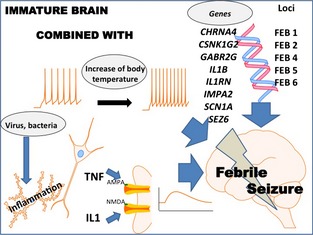Figure 1.

Mechanisms of FSs. The association of several factors is involved in each patient, among which are an immature brain, an increase in body temperature, inflammatory responses, genetics, and viral infection. FSs are genetically complex disorders believed to be influenced by variations in several susceptibility genes. Six FS susceptibility loci have been identified: FEB1 (8q13‐q21), FEB2 (19p13.3), FEB4 (5q14‐q15), FEB5 (6q22‐q24), FEB6 (18q11.2), and FEB7 (21q22). Recently, several association studies on FSs have been reported, but the results vary among groups and no consistent or convincing FS susceptibility gene has emerged. IL‐1β increases NMDA receptor function through the activation of tyrosine kinases and subsequent phosphorylation of the NR2A/B (GluN2A/B) subunit, resulting in an increase in NMDA‐induced calcium influx. TNF α causes an increase in the surface expression of neuronal AMPA receptors, responsible for an increase in synaptic efficacy. Viral infections are the most common causes of fever in cases of FSs. Human herpesvirus‐6 and influenza are frequently discussed as possible inducing factors for FSs because of their neurotropic properties, but the role of the viruses and the related inflammatory response remain poorly understood.
